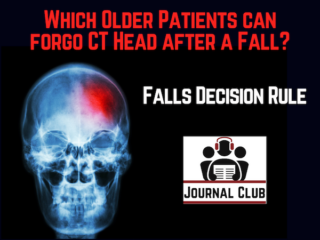Most Recent
Journal Club 6 Which Older Patients Can Safely Forgo CT Head After a Fall? The Falls Decision Rule
The decision of whether or not to order a CT head for an older patient who falls is one I need to make on almost every shift. The Canadian CT Head Rule does not apply to older patients. Does the recently derived Falls Decision Rule give us an answer to the question of which older patients can safely forego a CT head after a fall? Dr. Rohit Mohindra reviews the latest evidence in this EM Cases Journal Club...
Ep 196 Pediatric Meningitis Recognition, Workup and Management
In this episode: recognition, risk stratification, decision tools, indications for lumbar puncture in the febrile pediatric patient, tips and trick on performing LPs in children, and ED management of pediatric meningitis. We answer such questions as: what are the test characteristics of the various clinical features of meningitis across various ages? How does one differentiate between meningitis and retropharyngeal abscess on physical exam? How do the Canadian and American guidelines on work up of well-appearing febrile infants compare when to it comes to indications for lumbar puncture? Which patients with suspected meningitis require imaging prior to lumbar puncture? How do we best interpret the various CSF tests to help distinguish between viral and bacterial meningitis? What are the indications and timing of administering dexamethasone in the pediatric patient with suspected meningitis? and many more.... EM Cases is Free Open Access; please consider a donation to help ensure that EM Cases remains Free Open Access on our donation page https://stg-emergencymedicinecases-emcstaging.kinsta.cloud/donation/
EM Quick Hits 57 – HIV Diagnosis, Failed Paradigm of STEMI Criteria, Poisoned Patient Airway Management, Spontaneous Bacterial Peritonitis, DIY Investments
In this month's EM Quick Hits podcast: Megan Landes on the importance of diagnosing HIV in the ED, Jesse McLaren on the failed paradigm of STEMI criteria and ECG tips to identify acute coronary occlusion, Anand Swaminathan on evidence for non-invasive airway management in the poisoned patient, Brit Long and Hans Rosenberg on the identification, workup and management of spontaneous bacterial peritonitis, Matt Poyner on the most lucrative side-gig, DIY investing. To support EM Cases, please consider a donation here: https://stg-emergencymedicinecases-emcstaging.kinsta.cloud/donation/
ECG Cases 50 – STEMI: A Failed Paradigm, Enter Occlusion MI
Dr. Jesse McLaren illustrates the paradigm shift from STEMI to Occlusion MI (OMI) through 9 cases, and drives home the points that if there is STEMI criteria, consider false positives (eg. secondary and proportional to LVH or BER); if there is no STEMI criteria, consider false negatives and look for other signs of occlusion (eg. acute Q waves or loss of R waves, hyperacute T waves, or reciprocal STD/TWI) and if the ECG is nondiagnostic, consider other OMI signs including clinical (refractory ischemia, hemodynamic/electrical instability) and POCUS (new regional wall motion abnormalities).
Ep 195 Management of Subarachnoid Hemorrhage
Once the diagnosis of nontraumatic subarachnoid hemorrhage (SAH) has been made, our job is not done. Mortality in SAH patients can be up to 30% even without neurological deficit. Paying attention to the time-sensitive details of ED management of SAH patients can have a significant impact on their outcome. In this second part of our 2-part podcast series on subarachnoid hemorrhage with Dr. Katie Lin and Dr. Jeff Perry we answer questions such as: what are the 4 critical priorities in the initial stabilization of the patient with a suspected massive subarachnoid hemorrhage? When is a CT plus CTA of the head indicated up front in the management of patients with suspected subarachnoid hemorrhage? What is the evidence for oral nimodipine in improving outcomes in patients with subarachnoid hemorrhage and how does it work? What can we do in the ED to prevent rebleeding in patients with subarachnoid hemorrhage? What are the simplest and best prognostic tools available for spontaneous subarachnoid hemorrhage to help counsel families and patients? and more...
WTBS 30 Lessons on Emergency Medicine Leadership: The Role of The Leader
Dr. Howard Ovens reflects on the role of leader in the EM in this 2nd part of a 2-part Waiting to Be Seen blog series on EM leadership. He touches on mentoring, being committed, aligning with patients' interests, being a role model and a few quick takes on some controversial issues in EM...







